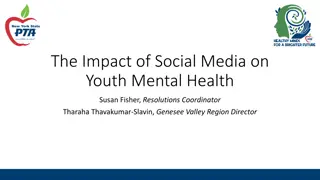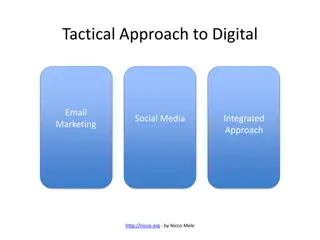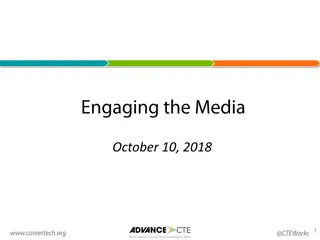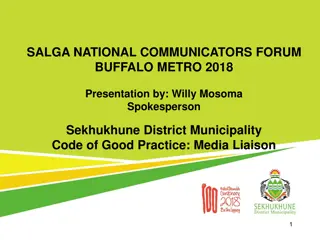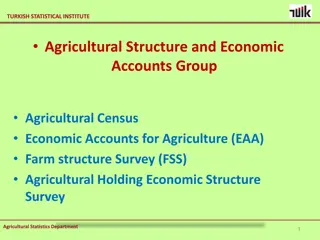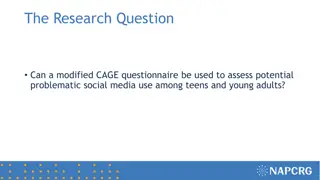Enhancing Agricultural Engagement through Social Media Applications
Social media applications such as Facebook, Twitter, Instagram, YouTube, WhatsApp, and LinkedIn offer valuable platforms for connecting, sharing information, and engaging with the agricultural community. These platforms facilitate communication, networking, information sharing, education, training, market access, and promotion within the agriculture sector. Leveraging these tools can help farmers, agricultural organizations, and industry professionals stay updated, showcase their work, and collaborate effectively.
Download Presentation

Please find below an Image/Link to download the presentation.
The content on the website is provided AS IS for your information and personal use only. It may not be sold, licensed, or shared on other websites without obtaining consent from the author.If you encounter any issues during the download, it is possible that the publisher has removed the file from their server.
You are allowed to download the files provided on this website for personal or commercial use, subject to the condition that they are used lawfully. All files are the property of their respective owners.
The content on the website is provided AS IS for your information and personal use only. It may not be sold, licensed, or shared on other websites without obtaining consent from the author.
E N D
Presentation Transcript
Lecture 25: Types and functions of social media applications, guidelines for preparing social media content, engaging audience and data-analytics Centurion University of Technology and Management, Odisha, India
Social media applications offer valuable platforms for connecting, sharing information, and engaging with the agricultural community. Here are some types of social media applications commonly used in agriculture: Facebook: Facebook is a widely used social media platform that offers various features for agricultural engagement. Farmers, agricultural organizations, and industry professionals can create Facebook Pages or Groups to share updates, educational content, industry news, and connect with others in the agricultural community. Facebook also allows for live video streaming, event promotion, and targeted advertising. Twitter: Twitter is a microblogging platform that allows users to share short messages, known as tweets, with their followers. In agriculture, Twitter is often used to share real-time updates, industry news, research findings, and participate in agricultural discussions through hashtags related to farming, agribusiness, or specific agricultural topics. Instagram: Instagram is a visual-based social media platform that focuses on sharing photos and videos. It is commonly used in agriculture to showcase farm life, agricultural practices, livestock, crops, and agricultural products. Centurion University of Technology and Management, Odisha, India
YouTube: YouTube is a video-sharing platform where farmers, researchers, and agricultural organizations can upload and share educational videos, demonstrations, interviews, and farm tours. YouTube is an effective way to provide in-depth content, tutorials, and showcase the visual aspects of agriculture. WhatsApp: WhatsApp is a messaging application that allows individuals and groups to communicate via text, voice messages, and multimedia content. In agriculture, WhatsApp can be used for farmer groups, agricultural cooperatives, or extension services to share information, discuss challenges, and provide support in real-time. LinkedIn: LinkedIn is a professional networking platform widely used across industries, including agriculture. It allows individuals and organizations to create profiles, share industry news, job opportunities, and connect with other professionals. LinkedIn can be valuable for agricultural professionals seeking career opportunities, partnerships, or industry collaborations. Centurion University of Technology and Management, Odisha, India
Functions of social media applications Communication and Networking: Social media applications provide platforms for individuals and organizations to connect, build relationships, and network within the agricultural community. They facilitate direct communication, enabling farmers to interact with fellow farmers, experts, suppliers, buyers, and other stakeholders. Information Sharing: Social media platforms allow for the rapid dissemination of information and knowledge related to agriculture. Users can share updates, news, research findings, best practices, and relevant industry information with their networks. Education and Training: Social media applications play a significant role in agricultural education and training. Users can access educational content, tutorials, webinars, and online courses shared by experts or organizations. Market Access and Promotion: Social media platforms provide opportunities for farmers, agribusinesses, and agricultural organizations to promote their products, services, or events. Users can showcase their agricultural produce, connect with potential buyers, participate in online marketplaces, and leverage targeted advertising to reach their target audience. Centurion University of Technology and Management, Odisha, India
Collaboration and Crowdsourcing: Social media applications facilitate collaboration and crowdsourcing within the agricultural community. Users can seek input, advice, and support from their peers, exchange ideas, and collectively address challenges. This fosters innovation, problem-solving, and community-driven initiatives. Real-Time Updates and Alerts: Social media platforms allow for real-time updates and alerts related to agricultural events, weather conditions, market fluctuations, disease outbreaks, or regulatory changes. Users can stay informed about time-sensitive information and take appropriate actions accordingly. Community Engagement and Support: Social media applications foster community engagement and support within the agricultural industry. Users can join groups, participate in discussions, share experiences, and provide advice or emotional support to their peers. This sense of community strengthens relationships and promotes solidarity among agricultural stakeholders. Centurion University of Technology and Management, Odisha, India





